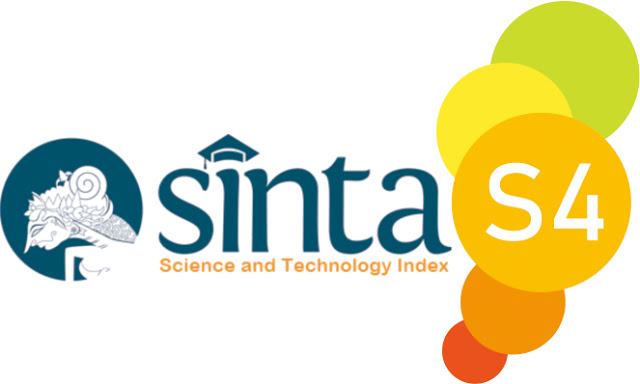Rule-Based Expert System Model with Backward Chaining Algorithm for Symptom-Based Skin Disease Diagnosis
Abstract
A rule-based expert system was a computational model designed to emulate expert decision-making using a knowledge base and inference algorithms. This research developed a rule-based expert system model with a backward chaining algorithm to diagnose skin diseases based on clinical symptoms. Backward chaining, a goal-driven inference method, started with a disease hypothesis (e.g., psoriasis) and verified related symptoms (e.g., kemerahan, sisik keperakan), enabling efficient differentiation of skin diseases with overlapping symptoms, such as dermatitis, psoriasis, and scabies. The model provided advantages in handling uncertainty, produced accurate diagnoses, and supporting interactive symptom verification. Developed using a knowledge base from credible sources like WHO and AAD, the model was intended to assist in clinical decision-making. The results showed that the backward chaining algorithm effectively improved the accuracy and efficiency of diagnosing skin diseases based on patient-reported symptoms
Downloads
References
C. J. Meneses and G. G. Grinstein, “Transactions on Information and Communications Technologies vol 19 © 1998 WIT Press, www.witpress.com, ISSN 1743-3517,” vol. 19, pp. 1–7, 1998.
I. Hatzilygeroudis, K. Dimitropoulos, K. Kovas, and J. A. Theodorou, “Expert Systems for Farmed Fish Disease Diagnosis: An Overview and a Proposal,” J. Mar. Sci. Eng., vol. 11, no. 5, 2023, doi: 10.3390/jmse11051084.
M. A. Richard et al., “Prevalence of most common skin diseases in Europe: a population-based study,” J. Eur. Acad. Dermatology Venereol., vol. 36, no. 7, pp. 1088–1096, 2022, doi: 10.1111/jdv.18050.
R. Spiewak, “Diseases from the Spectrum of Dermatitis and Eczema: Can ‘Omics’ Sciences Help with Better Systematics and More Accurate Differential Diagnosis?,” Int. J. Mol. Sci., vol. 24, no. 13, 2023, doi: 10.3390/ijms241310468.
S. Chatterjee, D. Dey, S. Munshi, and S. Gorai, “Dermatological expert system implementing the ABCD rule of dermoscopy for skin disease identification,” Expert Syst. Appl., vol. 167, 2021, doi: 10.1016/j.eswa.2020.114204.
X. Wu, F. Yang, and R. Zhang, “Frequent Misdiagnosis of Scabies as Eczema in China: A Descriptive Study of 23 Cases,” Int. J. Gen. Med., vol. Volume 17, no. April, pp. 1615–1623, 2024, doi: 10.2147/ijgm.s458731.
L. Lugović-Mihić, M. D. Aždajić, and I. Bešlić, “Scabies Cases Misdiagnosed and Treated As Allergic Diseases: Itch As Alarm,” Acta Clin. Croat., vol. 61, no. 2, pp. 349–353, 2022, doi: 10.20471/acc.2022.61.02.22.
T. M. Fan, “Cancer Patients,” Vet. Anesth. Analg. Fifth Ed. Lumb Jones, pp. 993–1003, 2023, doi: 10.1002/9781119421375.ch55.
J. Katz, S. Yue, and W. Xue, “Herpes simplex and herpes zoster viruses in COVID-19 patients,” Ir. J. Med. Sci., vol. 191, no. 3, pp. 1093–1097, 2022, doi: 10.1007/s11845-021-02714-z.
L. Muchlis and F. K. Putra, “Expert System Model of Forward and Backward Chaining Methods to Detect Student Academic Stress Level,” Educ. Innov. Ment. Heal. Ind. Era 4.0, pp. 88–93, 2020, doi: 10.1515/9783110679977-013.
S. Kamley, “Performance Comparison between Forward and Backward Chaining Rule Based Expert System Approaches Over Global Stock Exchanges,” Int. J. Comput. Sci. Inf. Secur., vol. 14, no. 3, p. 3153883, 2016.
M. Kazemi, N. Kim, D. Bhatia, X. Xu, and D. Ramachandran, “LAMBADA: Backward Chaining for Automated Reasoning in Natural Language,” Proc. Annu. Meet. Assoc. Comput. Linguist., vol. 1, pp. 6547–6568, 2023, doi: 10.18653/v1/2023.acl-long.361.
R. Rachman, S. Armayanti, and T. Kusnandar, “Web-Based Expert System For Respiratory Disorders In Human Using Backward Chaining Method,” Informatics Manag. Eng. Inf. Syst. J., vol. 1, no. 1, pp. 35–38, 2023, doi: 10.56447/imeisj.v1i1.214.
S. Y. Choi and S. H. Kim, “Knowledge acquisition and representation for high-performance building design: A review for defining requirements for developing a design expert system,” Sustain., vol. 13, no. 9, 2021, doi: 10.3390/su13094640.
D. A. Prambudi, C. E. Widodo, and A. P. Widodo, “Expert System Application of Forward Chaining and Certainty Factors Method for the Decision of Contraception Tools,” E3S Web Conf., vol. 31, pp. 1–6, 2018, doi: 10.1051/e3sconf/20183110009.
Paryati and S. Krit, “Expert System for Early Detection and Diagnosis of Central Nervous Diseases in Humans with Forward Chaining and Backward Chaining Methods Using Interactive Multimedia,” ITM Web Conf., vol. 43, p. 01016, 2022, doi: 10.1051/itmconf/20224301016.
S. P. Leo Kumar, “Knowledge-based expert system in manufacturing planning: state-of-the-art review,” Int. J. Prod. Res., vol. 57, no. 15–16, pp. 4766–4790, 2019, doi: 10.1080/00207543.2018.1424372.
B. Y. Elhabil and S. S. Abu-Naser, “An Expert System for Ankle Problems,” Int. J. Eng. Inf. Syst., vol. 5, no. 4, pp. 57–66, 2021, [Online]. Available: www.ijeais.org/ijeais
X. Huang et al., “A Generic Knowledge Based Medical Diagnosis Expert System,” ACM Int. Conf. Proceeding Ser., vol. 1, no. 1, pp. 462–466, 2021, doi: 10.1145/3487664.3487728.
D. Makolo, Y. Sunday, O. Kolawole Riches, S. Eneji, and O. Kayode Oladipupo, “Applications and Analyses of Inference Engine for Rule-Based System,” no. August, 2024, [Online]. Available: www.irjmets.com
E. Ogheneovo and P. Nlerum, “Knowledge Representation in Artificial Intelligence and Expert Systems Using Inference Rule,” Int. J. Eng. Res., vol. 11, no. April, pp. 1886–1900, 2020.
R. Fiati and D. Kurniati, “Backward Chaining Model for Identifying Learning Difficulties Experienced by Special Needs Children,” Sci. J. Informatics, vol. 9, no. 1, pp. 104–110, 2022, doi: 10.15294/sji.v9i1.33872.
R. R. Al-Hakim et al., “Rule-based ai system for early paediatric diabetes diagnosis using backward chaining and certainty factors,” BIO Web Conf., vol. 152, pp. 1–12, 2025, doi: 10.1051/bioconf/202515201020.
S. K. Chase, “Knowledge representation in expert systems. Nursing diagnosis applications.,” Comput. Nurs., vol. 6, no. 2, pp. 58–64, 2024.
C. Wang, F. Pastore, A. Goknil, and L. C. Briand, “Automatic Generation of Acceptance Test Cases from Use Case Specifications: An NLP-Based Approach,” IEEE Trans. Softw. Eng., vol. 48, no. 2, pp. 585–616, 2022, doi: 10.1109/TSE.2020.2998503.
Copyright (c) 2025 Sandi Badiwibowo Atim, M. Yhogha Ismail Ibn Ibrahim

This work is licensed under a Creative Commons Attribution-ShareAlike 4.0 International License.
This is an open-access article distributed under the terms of the Creative Commons Attribution-ShareAlike 4.0 International License which permits unrestricted use, distribution, and reproduction in any medium. Users are allowed to read, download, copy, distribute, search, or link to full-text articles in this journal without asking by giving appropriate credit, provide a link to the license, and indicate if changes were made. All of the remix, transform, or build upon the material must distribute the contributions under the same license as the original.















